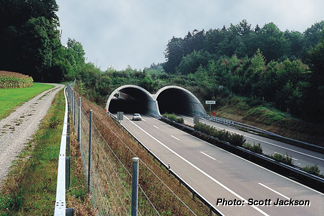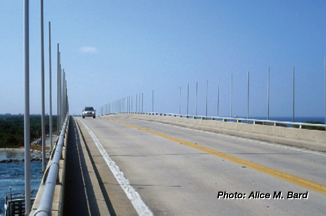Road Ecology:
Strategies for Reduction
Jean-François Dubois
In a prior article,
I offered an overview of the environmental principles which guide roadway
engineers at the conception stage of their projects. This time, I will focus
on specific types of recourse engineers have to eliminate or reduce the
impacts on faunal habitats.
Culverts For fish
While traveling over roadways, we not only fail to see the streams beneath
us but also the fish lining in them. The culverts which permit crossing
over these streams, in their various shapes and sizes, often become "dams"
and prevent fish from freely swimming towards their spawning zones. Accumulated
debris, the difference between the height of the base of the culvert and
the surface of the water, as well as the modification of the hydraulic characteristics
of these, are the main sources for problems.
In the case of a new construction or a replacement, engineers can prevent
these irritants and regulate construction to minimize the impact on aquatic
life. The basic idea is to reproduce, as much as possible, the natural conditions
of the site and make sure that the water level is not raised nor the flow
increased.
 Tunnels for Amphibians Tunnels for Amphibians
Too often, a road is situated close to a marshy zone where certain species
of amphibians reside. Since these roads do not necessarily circumvent the
entire habitat, they, to some extent, create a barrier against the migration
of the species for its reproduction.
In 1999, the Florida Department of Transportation (FDOT) initiated a
pilot project which consisted of building a 2,9 km wall measuring 1,1 m
in height along Highway 411. One of the characteristics of this wall is
a small lip, about 15 cm wide, situated at the top of the wall which prevents
the animals from climbing over it. Any animal attempting to climb over the
lip is forced to let go due to gravity. The wall is connected to four tunnels
placed between four existing culverts. Animals coming upon this wall are
naturally directed towards the tunnels and the culverts which enable them
to cross the road without danger. The project, titled "Ecopassage",
was completed in December of 2000 and has already received the prestigious
Globe Engineering Award.
 Moose Crossing Moose Crossing
Closer to home, a research project is currently underway in a wildlife
reserve in the Laurentians. On Highway 169, an electric fence was installed
for a length of approximately 10 km to direct moose, numerous in this sector,
towards a specific passageway. Upon arriving there, the moose crosses a
laser beam which sets off a system of lights on a specially identified panel.
The motorist who sees the flashing lights on this panel can already expect
to see a moose on the roadway or close by which enables him to adjust his
driving in accordance with this information. This is a perfect example of
how the concept of road ecology can be used and its direct impact on the
safety of the road users. This research project is carried out by the Direction
générale de Québec et de l'Est of the Ministry of Transports
of Quebec.
Animal Crossings
Much rarer in Canada than in Europe, animal crossings are actual structures
spanning a road axis (a highway for example) on which one recreates an environment
similar to that found on the road axis. Here one will find grass, rocks,
trees and sometimes even watering holes and marshes! This constitutes a
natural crossing for the animal and prevents it from having to circulate
through traffic.
 Vertical posts for marine birds Vertical posts for marine birds
Close to Melbourne Beach in south-east Florida, collisions with migrating
marine birds were so frequent on a bridge spanning the junction of two rivers,
that officials in charge of the Department of Transport (FDOT), in collaboration
with the Department of Environmental Protection (FDEP), organized the installation
of 122 metal posts measuring 2,8 m in height on both side of the bridge
in order to force the birds to fly higher. The posts are spaced just close
enough to discourage the birds from passing between them.
A study then concluded that these posts were responsible for a reduction
in the number of fatal accidents by almost 64%. This method is particularly
beneficial for younger birds who are not able to properly judge the correct
height of flight to be adopted.
These are just a few examples of what can be achieved in regards to road
ecology in order to help preserve wildlife habitats. There are many more
ways. What we need to remember is that the success of these methods rests
on an effective dialogue between the individuals involved in the fields
of transport and the environment. A relatively new concept, road ecology
is an area where open-mindedness and ingenuity go hand in hand. | 






